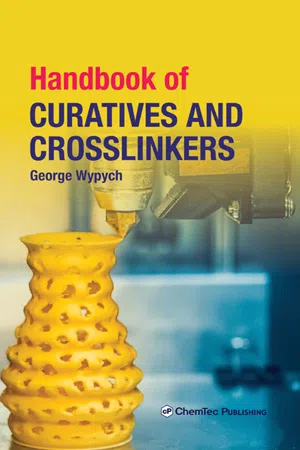
- 264 pages
- English
- ePUB (mobile friendly)
- Available on iOS & Android
Handbook of Curatives and Crosslinkers
About this book
Handbook of Curatives and Crosslinkers presents the mechanisms of action of these additives, methods of their use, their effects on properties of transformed products, and their applications. Chapters cover the common use of curatives in many industrial products manufactured in large scale, such as adhesives, sealants, coatings, inks, explosives, propellants and foams, and in emerging products, such as optoelectronics, shape-memory applications, light-emitting diodes, and more. In addition, crosslinkers used in typical industrial processing methods, such as solar cells, vulcanization, adhesives, foams and roofing are covered. Each section presents the effect of the additive, including an evaluation of its chemical and physical properties.- Covers the use of curatives in emerging products, such as optoelectronics, shape-memory applications, light-emitting diodes, liquid crystal displays, self-healing materials, etc.- Presents emerging applications, such as drug release, artificial muscles in microdevices, autonomous shape-memory actuators, hygienic textiles, membranes, scaffolds, recycling, sensors, tissue adhesives, wound dressing, and many more
Frequently asked questions
- Essential is ideal for learners and professionals who enjoy exploring a wide range of subjects. Access the Essential Library with 800,000+ trusted titles and best-sellers across business, personal growth, and the humanities. Includes unlimited reading time and Standard Read Aloud voice.
- Complete: Perfect for advanced learners and researchers needing full, unrestricted access. Unlock 1.4M+ books across hundreds of subjects, including academic and specialized titles. The Complete Plan also includes advanced features like Premium Read Aloud and Research Assistant.
Please note we cannot support devices running on iOS 13 and Android 7 or earlier. Learn more about using the app.
Information
INTRODUCTION
CROSSLINKERS
| GENERAL INFORMATION | ||
| Chemical components: aziridine, carboxylic acids, dicumyl peroxide, fatty acid trimer, hydrogenpolysiloxane, isocyanate, modified inorganic fillers, N,N’-methylenebisacrylamide, organic peroxide, oxime silane, pentaerythritol derivative, peroxyketal, polyamide-epichlorohydrin, polyaziridine, polycarbodiimide, polydimethylsiloxane, polyrotaxane, polythiol, silane, sodium tetraborate, titanate, triallyl cyanurate, triallyl isocyanurate, triallyl trimellitate, trismaleimide, zirconate | ||
| Molecular weight: 148-1394 | Average functionality: 2.5-3.3 | Solids content, wt%: 12-100 |
| Active oxygen content, %: 2.06-11.17 | NCO content, %: 30.5-33.5 | |
| Ti content, %: 3.3-20.5 | ||
| PHYSICAL DATA | ||
| Color: colorless, white, yellow, brown, blue, red | State: liquid, paste, or solid | |
| Odor: odorless, amine, aromatic, ether, menthol, solvent | ||
| Acid number, mg KOH/g: 1-25 | pH: 2-11.5 | |
| Activation energy, kcal/mol: 36.8-38.1 | Density, kg/m3: 800-1630 | |
| Boiling point, °C: 17->390 | Melting/freezing point, °C: 235 to -70 | |
| Glass transition temperature, °C: -5 to -10 | Vapor density: 1-11.7 | |
| Half life: 1 min/140-193°C to10 h/99-131°C | ||
| Refractive index: 1.384-1.5675 | ||
| Solubility: acetone, benzene, butanol, chloroform, diethyl ether, dioxane, DMF, DSMO, ethanol, ethyl acetate, hydrocarbons, isopropanol, methanol, methyl ethyl ketone, n-heptane, toluene, water, xylene | ||
| Vapor pressure, kPa @20°C: 1.7E-07 to 3.86 | ||
| Viscosity, mPa s @20°C: 5.7 to 9000 | ||
| HEALTH & SAFETY | ||
| Autoignition temperature, °C: 220-600 | Flash point, °C: 6-290 | |
| HMIS: Fire: 0-4; Health: 0-3; Reactivity: 0-3 | ||
| NFPA: Flammability: 0-3; Health: 0-3; Reactivity: 0-2 | ||
| Carcinogenicity: IARC, NTP, OSHA: No component of this product present at level greater than or equal to 0.1% is identified as probable, possible, or confirmed human carcinogen; to suspected carcinogen | ||
| Mutagenicity: none to suspected to category 1B | ||
| Teratogenicity: none to category 1A | ||
| Explosive concentration, %: LEL: 1.4-2; UEL: 7-19.9 | ||
| LC50: Inhalation-rat, ppm: >5->800; Dermal-rabbit, mg/kg: >1000-12800; Oral-rat, mg/kg: 390->7000 | ||
| UN/NA class: 1219, 1263, 1760, 1824, 1933, 3077, 3082, 3101, 3103, 3105, 3106, 3107, 3108, 3110, 3335 | ||
| UN risk phrases: R10,R20,R21/22,R22,R36/38,R38, R41,R43,R52/53,R68 | ||
| UN safety phrases: S7,S17,S26,S27,S35, S36/37/38,S44,S47 | ||
| ECOLOGICAL PROPERTIES | ||
| Aquatic toxicity, EC50, mg/l: Algae: 0.8->100/72H, Bluegill sunfish: >603->1000; Daphnia magna: 0.31->1000/48H; Fathead minnow: 6.32-40; Zebra fish: 1.6->1000 | ||
| Bioaccumulation: not expected to low | ||
| Bioconcentration factor, BCF: 6.49-839 | ||
| Partition coefficient, log Kow: 2.2-7.3 | ||
| APPLICATIONS | ||
| Recommended for resins: ABS, acrylamide, acrylics, alkyd, biopolymers, bromobutyl rubber, butyl rubber, carboxymethyl cellulose, cellulose acetate butyrate, cellulose acetate propionate, chlorinated polyethylene, chloroprene, cyanoacrylate, epoxidized natural rubber, EPDM, epoxy, EVA, fluoroelastomers, guar, high impact polystyrene, hydrogenated nitrile rubber, natural rubber... | ||
Table of contents
- Cover image
- Title page
- Table of Contents
- Copyright
- Chapter 1: INTRODUCTION
- Chapter 2: CROSSLINKERS
- Chapter 3: CURATIVES
- INDEX